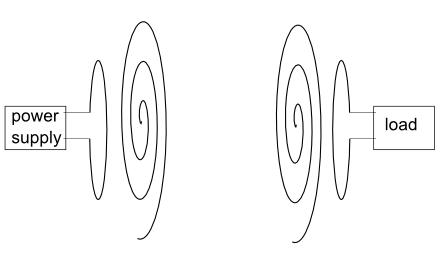Wireless Charging-Magnetic Resonant Power Transmission
The resonant wireless charging technology is still based on the principle of electromagnetic induction, but it has the transmitter coil and receiver coil in a particular resonant frequency, that enhances the coupling between the two coils. The strong coupling makes the receiver coil include an electrical current even it is taken away from the transmitter coil some distance like dozen centimeters. The second benefit is that the resonant power transmission does not rely on the overlay degree between the primary driver coil and the secondary coil much, and the third benefit is that one primary coil can transmit power energy to multiple secondary coils simultaneously. All these advantages make the placement of the devices to be charged more free, for example, fix a resonant power transmitter at the bottom of a tabletop then once people put their phones on the table the wireless powering starts immediately.

In 2014, the A4WP (Alliance for Wireless Power) led by Qualcomm, Samsung, Broadcom, and Intel released a wireless powering standard named Rezence. Rezence created the unified specifications that high-frequency resonant wireless charging system should adhere, thus ensuring the compatibility among devices of different manufacturers.
Rezence standard has three major characteristics compared with Qi standard:
1) 6.78MHz working frequency. That is 30 – 60 higher than Qi's working frequency. The high power transmission frequency means devices to be charged can get sufficient voltage in a wide space range, and on account of the magnetic resonance which makes the power transfer tunnel smooth so the Rezence can achieve effective energy transfer far and wide. At present, the Rezence wireless charger is able to transmit up to 50W power up to 5 centimeters far away.
2) Magnetic resonance. The resonance parameters of the transmitter coil and receiver coil are the same. Qi standard can also use magnetic resonance, but because of its low working frequency the spatial usage freedom of the Qi device is much lower than that of the Rezence device.
3) Bluetooth communication. Rezence adopts Bluetooth to communicate instead of the magnetic coupling, that ensures the reliability of the communication and supports one-to-many synchronous communication.
Then, what's disadvantage of the resonant wireless charging?
1. The first is the energy loss is great in the transmission – 2 centimeters transmission will lose 20% of the power energy and the power energy remains only 15% when it reaches at 75 centimeters. That is not a green action.
2. Secondly, the working frequency of the resonant power transmission is usually high, and that may interferes with other electronic devices around.
3. The third disadvantage is the complicated circuit design. Those disadvantages and difficulties cause that there have been no manufacturer that can bulk produce the wireless charger which follow the Rezence standard and put to the market since the release of the Rezence 4 year ago. Intel, the member of the A4WP and had clung to wireless charging, suddenly implemented significant employee layoffs in its wireless charging business and remained a few to follow how the wireless charging market works, and another A4WP member WiTricity, a company born out of the MIT labs, seems more interested in the car wireless powering market than the phone wireless charging market. But, as there are few phone brands that support Rezence standard on today's market, users have to plug an extra receiver device into their phones before wireless powering, and that greatly reduces the user experience.
The Qi standard, by contrast, is being supported by more and more phone brands after Apple started using Qi charging standard on its iPhone 8 and X, and no accident, the Qi phones will be everywhere in 2-3 years. If the Rezence still doesn't have some new developments, it's just a matter of time before it will be defeated by Qi.
- Pre:Does the Wireless Charger Hurt the Phone 2020/3/24
- Next:The Main Three Charging Technologies Of Wireless Charger 2020/3/5
